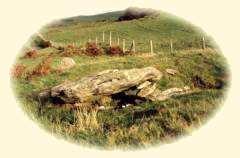| | Hafan Home | | | | Chwilio Search | | | | Hanes a dogfennau History & records | | | | Hynafiaethau Antiquities |
|
Bedd Taliesin |
The grave of Taliesin |
|
Yn ôl traddodiad, magwyd Taliesin Ben Beirdd yn yr ardal hon. Yn ei henaint, fe ddaeth yn ôl i farw yma, ac yn awr y mae'n gorwedd yn ei fedd ymhlith y bryniau uwchben y pentref a enwyd ar ei ôl, sef Tre-Taliesin. Mae'r fedd yn dal i'w gweld heddiw. Mae nifer ychwanegol o luniau o'r fedd ar gael yn adran yr Oriel. |
 |
According to tradition, Taliesin, the greatest of Welsh poets, grew up in the area around Llangynfelyn. In his old age, he returned to die here, and now lies buried in the hills above the village named after him:- Tre-Taliesin. The grave is still to be seen. Some more photographs of the grave are available in the picture section. |
||
Ar y tudalen hwn... |
On this page... |
|||
|
|
|||
Dogfennau eraill ar y wefan |
Other documents on the site |
|||
| Cwestiynau? Sylwadau? Beth ydych chi'n meddwl am y tudalen hwn a gweddill y wefan? Dywedwch yn y llyfr ymwelwyr. Questions? Comments? What do you think about this page and the rest of the site? Tell us in the guest book. |